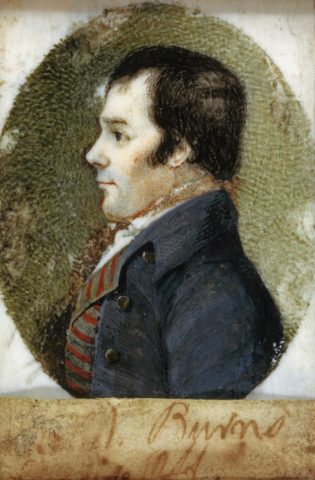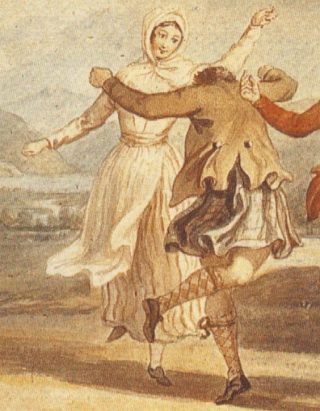 “There grows a bonie brier-bush” is a traditional Scottish song modified by Robert Burns for editorial purpose and published in 1796 in the “Scots Musical Museum”; the double meaning concerned both the allusion to the relationship between a Jacobite rebel “Highland laddie” and a “Lowland lassie” follower of King George that the erotic context of the relationship (as we find it in the variant”The Cuckoo’s nest“)
“There grows a bonie brier-bush” is a traditional Scottish song modified by Robert Burns for editorial purpose and published in 1796 in the “Scots Musical Museum”; the double meaning concerned both the allusion to the relationship between a Jacobite rebel “Highland laddie” and a “Lowland lassie” follower of King George that the erotic context of the relationship (as we find it in the variant”The Cuckoo’s nest“)
A version is also adapted by Carolina Oliphant, always on the melody “The Brier Bush”.
James Malcolm in The Complete Songs of Robert Burns Vol V, 1998
Jean Redpath in Songs of Robert Burns, Vol. 3 & 4 1996 ♪
Junkman’s Choir in The Burns Sessions – Footage of recordings from inside Robert Burns’ Cottage, Alloway, Scotland (January 2018)
| I There grows a bonnie brier-bush (1) in our kail-yard (2), There grows a bonnie brier-bush in our kail-yard; And below the bonnie brier-bush there’s a lassie and a lad, And they’re busy, busy courting in our kail-yard. II We’ll court nae mair below the buss in our kail-yard, We’ll court nae mair below the buss in our kail-yard; We’ll awa to Athole’s green (3), and there we’ll no be seen, Whare the trees and the branches will be our safe-guard. III ‘ Will ye go to the dancin in Carlyle’s ha’ (4)? Will ye go to the dancin in Carlyle’s ha’ ? Where Sandy (5) and Nancy I’m sure will ding (6) them a’?’ ‘ I winna gang to the dance in Carlyle ha.’ |
IV What will I do for a lad when Sandy gangs awa? What will I do for a lad when Sandy gangs awa ? I will awa to Edinburgh, and win a penny fee (7), And see an onie bonnie lad will fancy me. V He’s comin frae the North that’s to fancy me, He’s comin frae the North that’s to fancy me ; A feather in his bonnet and a ribbon at his knee (8), He ‘s a bonnie, bonnie laddie, and yon be he ! |
NOTES
Enghish translation *
1) in the ballads the rose is not only “a rose” but it is the symbol of love, symbolizes here the loss of virginity, the thorns are also a memento to the dangers of a sexuality outside of marriage
2) kail-yard is the garden in front of the door of the cottage, it has become synonymous with a group of storytellers of the end of the 19th century who often described Scottish rural life, often using dialectal forms.
3) Athole: Atholl is located in the heart of the Scottish Highlands and derives its name from the Gaelic “ath Fodla” or New Ireland following the invasions in the island of the Irish tribes in the seventh century, Athole is the old name for the area of Perthshire
4) “Carlisle Castle is situated in Carlisle, in the English county of Cumbria, near the ruins of Hadrian’s Wall. Given the proximity of Carlisle to the border between England and Scotland, it has been the centre of many wars and invasions. The most important battles for the city of Carlisle and its castle were during the Jacobite rising of 1745 against George II of Great Britain” (da Wiki)
5) Sandy is short for Alexander
6) to ding= overcome; wear out, weary; to beat, excel, get the better of.
7) penny fee= wages 8) in the eighteenth century there were no stretch fabrics so as to support the socks to the calves of the man (and the thighs of women) were used garters or ribbons turned several times around the leg and knotted (among which we must hide a small dagger) , even those who wore pants (adhering a bit like a tights) used to tie ribbons under the knee
8) in the eighteenth century there were no stretch fabrics so as to support the socks to the calves of the man (and the thighs of women) were used garters or ribbons turned several times around the leg and knotted (among which we must hide a small dagger) , even those who wore pants (adhering a bit like a tights) used to tie ribbons under the knee
Lady Nairne’s version is often dismissed by critics as an imitation of Burns’ version and unfortunately many were prejudices against her literary production ..
| CAROLINA OLIPHANT VERSION I There grows a bonnie brier-bush in our kail-yard, And white are the blossoms o’t in our kail-yard; Like wee bit cockauds (1) to deck our Hieland lads And the lasses lo’e the bonnie bush in our kail-yard. II An it’s hame, an’ it’s hame to the north countrie, An’ it’s hame, an’ it’s hame to the north countrie, Where my bonnie Jean is waiting for me, Wi’ a heart kind and true, in my ain countrie. III But were they a’ true that were far awa’? Oh! were they a’ true that were far awa’? They drew up wi’ glaikit Englishers at Carlisle ha’, And forgot auld frien’s that were far awa’. IV “Ye’ll come nae mair, Jamie, where aft ye have been, Ye’ll come nae mair, Jamie, to Atholl’s green; Owre weel ye lo’ed the dancin’ at Carlisle ha’, And forgot the Hieland hills that were far awa’.” V “I ne’er lo’ed a dance but on Atholl’s green, I ne’er lo’ed a lassie but my dorty Jean, Sair, sair against my will did I bide sae lang awa’, And my heart was aye in Atholl’s green at Carlisle ha’.” VI The brier bush was bonny ance in our kail-yard; That brier bush was bonny ance in our kail-yard; A blast blew owre the hill, that ga’e Atholl’s flowers a chill, And the bloom’s blawn aff the bonnie bush in our kail-yard. |
English translation Cattia Salto I There grows a lovely brier-bush in our kitchen garden And white are the blossoms out in our kitchen garden, Like tiny rosettes to deck our Highland lads And the lasses love the lovely bush in our kitchen garden. II And it’s home, and it’s home to the north country, An it’s home, and it’s home to the north country, Where my pretty Jean is waiting for me, With a heart kind and true, in my own country. III But were they all true that were far away? Oh! were they all true that were far away? They drew up with stupid Englishmen at Carlisle hall, And forgot old friends that were far away. IV “You’ll come no more Jamie, where often you have been, You’ll come no more, Jamie, to Atholl’s green; Over well you loved the dancing at Carlisle hall, And forgot the Highland hills that were far away.” V “I never loved a dance but on Atholl’s green, I never loved a lassie but my saucy Jean, Sore, sore against my will did I bide so long away, And my heart was always in Atholl’s green at Carlisle hall.” VI The brier bush was lovely once in our kitchen garden; That brier bush was lovely once in our kitchen garden; A blast blew over the hill, that gave Atholl’s flowers a chill, And the blooms blown off the lovely bush in our kitchen garden |
NOTE
1) the white cockade of the Jacobites
LINK
http://chrsouchon.free.fr/kailyard.htm
http://sangstories.webs.com/cuckoosnest.htm
https://mudcat.org/thread.cfm?threadid=86781
http://digital.nls.uk/special-collections-of-printed-music/archive/90262457
https://digital.nls.uk/broadsides/broadside.cfm/id/14959
